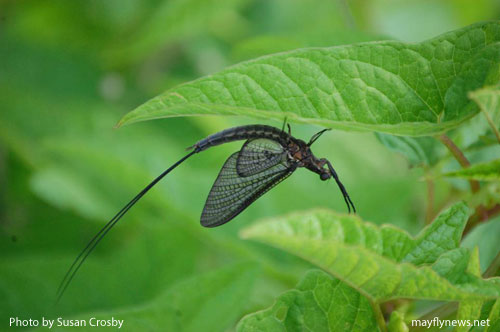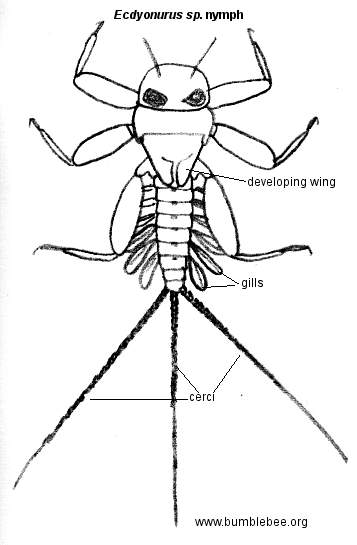
Habitat
Mayflies distribution is worldwide expect for in Antarctica, the high Arctic and some oceanic islands. A wide variety are found in freshwater habitats as they are considered a very important group of bottom-dwelling animals in the world. The majority of them inhabit actively moving temperate waters (Carde and Resh 2003).
As for distribution close to the Wisconsin area, there are at least 222 taxa, which includes species and subspecies, in 12 families that have been reported from the Great Lakes region (Dunn 1996).
 Nymphs
(larvae), as a sturdy creature,
inhabit fast-flowing streams and shallow ponds with high levels
of dissolved oxygen and low levels of pollutants. They are well
adapted for living at the bottom of bodies of water and four to
seven of the ten abdominal segments have gills for underwater
purposes. Adults are
found on vegetation near water (Papp
and Swan 1972).
Nymphs
(larvae), as a sturdy creature,
inhabit fast-flowing streams and shallow ponds with high levels
of dissolved oxygen and low levels of pollutants. They are well
adapted for living at the bottom of bodies of water and four to
seven of the ten abdominal segments have gills for underwater
purposes. Adults are
found on vegetation near water (Papp
and Swan 1972).
Mayflies are known to be sensitive to pollution in water, but
some can tolerate a certain level of contamination in their
habitat, which is why they are used as bioindicators of water
quality (Schlager 2004).
To learn more about Mayflies as bioindicators of water quality:
Follow this link
They are very limited in dispersal powers because of their weak
flying abilities and their short
 adult
life, which can be just for a few hours or up to a few days.
Although they are mostly limited to an aquatic habit, they are
an important part of the diet of many aquatic organisms
(Dunn 1996).
After they mate and drop their eggs into the water, the adults
usually jut fall back into the water thus resulting in food for the
fish (Bumblebee.org 2012).
adult
life, which can be just for a few hours or up to a few days.
Although they are mostly limited to an aquatic habit, they are
an important part of the diet of many aquatic organisms
(Dunn 1996).
After they mate and drop their eggs into the water, the adults
usually jut fall back into the water thus resulting in food for the
fish (Bumblebee.org 2012).
Return to homepage